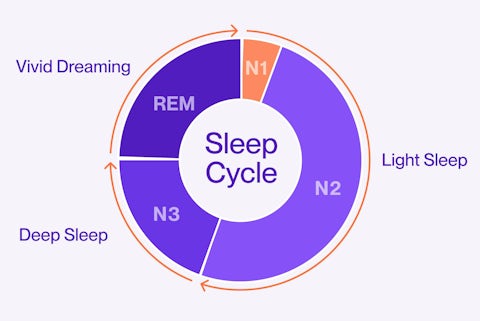Best Sleep Schedule for Night Shift Workers
 Andrew Jolie March 26, 2024 6 min read
Andrew Jolie March 26, 2024 6 min read
Are you a shift worker struggling for years to find a way to regulate your sleep schedule?
Up to 75% of shift workers struggle with sleep, and 10-40% may develop Shift Work Sleep Disorder (SWSD), affecting sleep quality due to misaligned circadian rhythms. SWSD causes trouble sleeping and drowsiness at unwanted times but is manageable with lifestyle changes, light therapy, and medication.
Having a regular sleep schedule helps you handle stress better and not get as annoyed by minor problems. It also leads to feeling more alert, safer with whatever you’re doing, and a healthier heart.
Understanding Ideal Sleep Patterns for Night Shift Workers
The biological clock, or circadian rhythm, is our body's natural timing device that regulates sleep-wake cycles, hunger, hormones, and other bodily functions. External cues, especially light, influence it, which helps determine when we feel awake or sleepy.
Night shift work clashes with our circadian rhythm, disrupting our internal schedule by keeping us awake when our body expects sleep, leading to sleep issues, fatigue, and health problems.
Adjusting Your Sleep Schedule for Night Shift Work
If you want to get a handle on adjusting your sleep schedule, here are some helpful tips to make it fit your night shift work.
- Shift Bedtime and Wake Time Gradually: Adjust your sleeping hours in 15- —to 30-minute increments each day toward the desired schedule for night shifts.
- Create a Night-like Sleep Environment for Daytime Rest: Use blackout curtains and reduce noise to simulate nighttime conditions, encouraging sleep during the day.
- Manage Light Exposure: Expose yourself to bright light during your night shift to stay alert, and avoid blue light exposure before sleeping during the day to help your body prepare for rest.
- Adjust Gradually: Implement these changes slowly to allow your body to adapt with minimal discomfort, promoting a healthier transition to night shift work.
Here are a few tips on creating a conducive sleeping environment during the day:
- Invest in a Good Quality Sleep Mask: If curtains aren’t enough, a sleep mask can provide additional darkness, signaling your brain that it’s time to rest. You can also try a Smart Sleep Mask, like the one from Bía, with neurofeedback and neural sounds to get you to sleep faster and more soundly.
- Minimize Noise: Use earplugs or a white noise machine to drown out daytime sounds that could interrupt your sleep.
- Keep the Room Cool: Maintain a comfortable, cooler room temperature, as a cool environment is conducive to sleep.
- Limit Caffeine: To help your body wind down, avoid caffeine at least an hour before your intended sleep time.
- Create a Pre-Sleep Routine: Engage in relaxing activities like reading or a warm bath to tell your body that it’s time to sleep.
- Ensure Comfortable Bedding: Invest in a comfortable mattress and pillows that support a restful day’s sleep.
Example of a Night Shift Sleep Schedule
This detailed schedule outlines an ideal sleep pattern for night shift workers, including times for sleep, meals, and other activities. This can help you understand what your schedule could look like and help adjust your night-shift sleeping patterns.
This schedule is designed to balance the demands of your night shift work and the natural needs of your body and mind. It acknowledges the importance of sleep, nutrition, physical activity, and personal time in maintaining health and well-being despite the challenges of working at night. You’ll obviously need to take this and adjust it to your needs to maximize the effectiveness.
Managing Sleep While Working the Night Shift
Managing sleep while on the night shift requires smart strategies to align your body’s natural rhythms with an unconventional schedule.
Light exposure is essential: bright light during work hours keeps you alert while minimizing light before sleep; using blackout curtains, eye masks or smart sleep masks like Bía, encourages your body to wind down.
Diet also plays a crucial role; opting for lighter, healthier meals before sleep can prevent discomfort, and moderating caffeine intake ensures it doesn’t hinder your ability to rest.
Regular exercise improves sleep by reducing stress and tiring you out, but avoid it near bedtime. Exercise during your waking hours to ensure your body has time to relax before sleep, enhancing night-shift sleep strategies.
How to Sleep During the Day When Working Nights
Use fans or noise machines to keep your bedroom cool and quiet so you can sleep well during the day. Weighted blankets and relaxation techniques like deep breathing or meditation before bed can also help you fall asleep faster.
For a combination of a few of these sleeping aids, the Bía Smart Sleep Mask covers blocking out light, using neural sounds to let the mind and body relax, and an app to monitor whether you’re getting enough sleep and sleeping well. You can fall asleep 3 x faster and sleep so much better.
FAQs about Night Shift Sleeping Schedule
Why Can't I Sleep After Working the Night Shift?
It can be tough to sleep after working the night shift because your body's internal clock, which tells you when it's time to sleep or wake up, gets confused. Normally, it expects you to sleep at night and be awake during the day. Also, the stress and alertness from working at night can make it harder to calm down and sleep once you're home. These physical and mental factors work together, making falling asleep after night shifts hard.
How Long Does It Take Your Body to Adjust to Night Shift?
Adapting to night shift work takes days to weeks, depending on individual sleep habits, lifestyle, and the degree of schedule change. Consistency in sleep routines, managing light exposure, diet, and a suitable daytime sleeping environment is crucial for a smoother transition and affect how quickly you adjust.
How Long Should You Sleep Before a Night Shift?
Before a night shift, aim for 7 to 9 hours of sleep for optimal alertness or at least a 90-minute nap to lessen sleepiness and boost performance. Aligning your sleep schedule with these tips can ease the transition to night work.
What Is the Best Nap Length for Night Shift Workers?
For night shift workers, ideal nap lengths are 20-30 minutes or a 90-minute cycle to enhance alertness without disrupting sleep patterns. Time your naps carefully to avoid sleep inertia and ensure they don't interfere with your main sleep schedule, helping you with fatigue management and a healthier sleep cycle.


